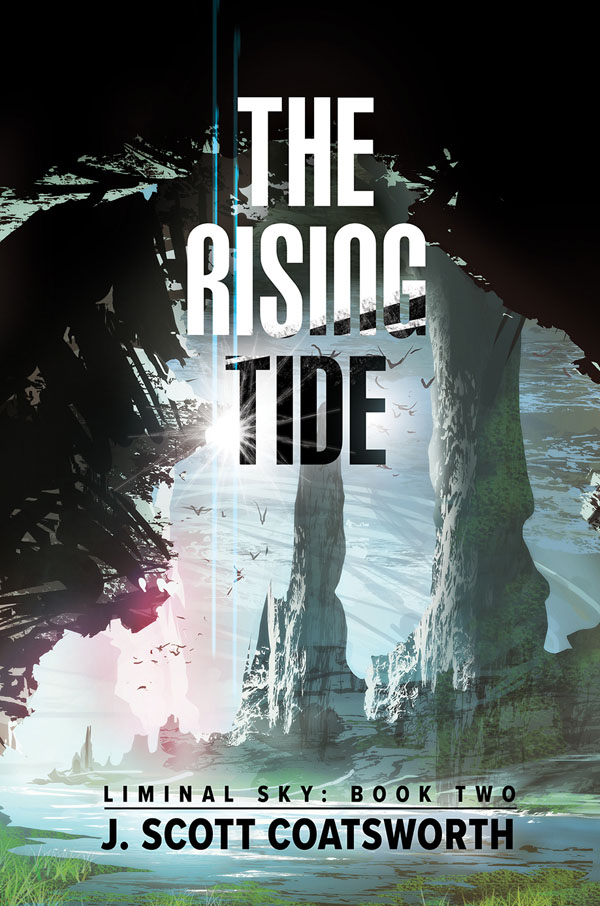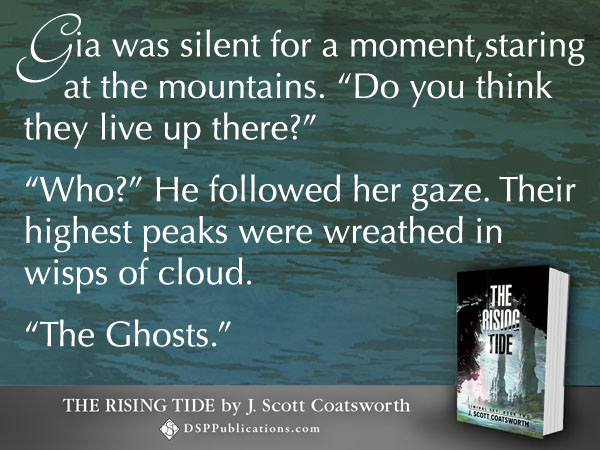It’s a book birthday for a fellow author! Book two in J. Scott Coatsworth’s queer SF series is out today. He’s a sweetheart, so I’m thrilled to host him here. And isn’t that cover pretty? Here are all the details about The Rising Tide…
J. Scott Coatsworth has a new queer sci fi book out: “The Rising Tide.”
Earth is dead.
Five years later, the remnants of humanity travel through the stars inside Forever, a living, ever-evolving, self-contained generation ship. When Eddy Tremaine and Andy Hammond find a hidden world-within-a-world under the mountains, the discovery triggers a chain of events that could fundamentally alter or extinguish life as they know it, culminate in the takeover of the world mind, and end free will for humankind.
Control the AI, control the people.
Eddy, Andy, and a handful of other unlikely heroes—people of every race and identity, and some who aren’t even human—must find the courage and ingenuity to stand against the rising tide.
Otherwise they might be living through the end days of human history.
Series Blurb: Humankind is on its way to the stars, a journey that will change it forever. Each of the stories in Liminal Sky explores that future through the lens of a generation ship, where the line between science fiction and fantasy often blurs. At times both pessimistic and very hopeful, Liminal Sky thrusts you into a future few would ever have imagined.
DSP Publications | Amazon | iBooks | Barnes & Noble | Kobo | QueeRomance Ink | Goodreads
Giveaway
Scott is giving away two prizes with this tour – a $25 Amazon gift card, and a signed copy of “The Stark Divide,” book one in the series (US winner only for the paperback). For a chance to win, enter via Rafflecopter:
Direct Link: http://www.rafflecopter.com/rafl/display/b60e8d4734/?
Excerpt
Eddy Tremayne rode his horse, Cassiopeia, along the edge of the pastures that were the last official human habitations before the Anatov Mountains. Several ranchers along the Verge—the zone between the ranches and the foothills—had reported losses of sheep and cattle in the last few weeks.
As the elected sheriff of First District, which ran from Micavery and the South Pole to the mountains, it was Eddy’s responsibility to find out what was going on.
He had his crossbow strapped to his back and his long knife in a leather sheath at his waist. He’d been carrying them for long enough now—three years?—that they had started to feel natural, but the first time he’d worn the crossbow, he’d felt like a poor man’s Robin Hood.
He doubted he’d need them out here, but sheriffs were supposed to be armed.
He’d checked with Lex in the world mind via the South Pole terminal, but she’d reported nothing amiss. In the last few years, she had begun to deploy biodrones to keep an eye on the far-flung parts of the world, but they provided less than optimal coverage. One flyover of this part of the Verge had shown a peaceful flock of thirty sheep. The next showed eight.
The rancher, a former neurosurgeon from New Zealand named Gia Rand, waited for him on the top of a grassy hill. The grass and trees shone with bioluminescent light, and the afternoon sky lit the surrounding countryside with a golden glow. The spindle—the aggregation of energy and glowing pollen that stretched from pole to pole—sparkled in the middle of the sky.
The rancher pulled on her gray braid, staring angrily at something in the valley below. “Took you long enough to get here.”
“Sorry. The train was out of service again.” Technology was slowly failing them, and they had yet to come up with good replacements.
She snorted. “One helluva spaceship we have here.”
He grinned. “Preaching to the choir.” Forever didn’t have the manufacturing base yet to support anything close to the technology its inhabitants had grown used to on Earth. Which wasn’t necessarily a bad thing, if you asked him. With technology came new and better ways to kill. He’d seen it often enough in the NAU Marines. “What did you find?”
“Look.” Her voice was almost a growl.
Eddy looked down where she was pointing. “Oh shit.” Her missing sheep were no longer missing. They had been slaughtered.
He urged Cassiopeia down the hillside to the rocky clearing. A small stream trickled down out of the mountains there. He counted ten carcasses, as near as he could tell from the skulls left behind. Someone had sheared a couple of them and given up. It looked like they had skinned and cut the rest up for meat, the skin and bones and extra bits discarded.
Gia rode down the hillside behind him.
“Didn’t you report twelve sheep missing?”
She nodded. “Bastards took the two lambs. Probably for breeding.”
“That actually might help us.”
“How’s that?”
He dismounted to take a closer look at the crime scene. “They’ll have to pasture them somewhere. May make it easier to track them down.”
“Maybe so.” She dismounted and joined him. “This was brutal work. Look here.” She picked up a bone. “Whatever cut this was sharp but uneven. It left scratch marks across the bone.”
“So not a metal knife.”
“I don’t think so. Maybe a stone knife?”
He laughed harshly. “Are we back to caveman days, then?” It wasn’t an unreasonable question.
She was silent for a moment, staring at the mountains. “Do you think they live up there?”
“Who?” He followed her gaze. Their highest peaks were wreathed in wisps of cloud.
“The Ghosts.”
The Ghosts had been a persistent myth on Forever since their abrupt departure from Earth. Some of the refugees had vanished right after the Collapse, and every now and then something would end up missing. Clothes off a line, food stocks, and the like.
People talked. The rumors had taken on a life of their own, and now whenever something went missing, people whispered, “It’s the Ghosts.”
Eddy didn’t believe in ghosts. He personally knew at least one refugee who had disappeared, his shipmate Davian. He guessed there must be others, though the record keeping from that time had been slipshod at best. He shrugged and looked at the sky. “Who knows?” It was likely to rain in the next day or so. Whoever had done this had left a trail, trampled into the grass. If he didn’t follow it now, it might be gone by the time he got back here with more resources.
Gia knelt by one of the ewes, staring at the remnants of the slaughter. “Could you get me some more breeding stock? This… incident put a big dent in my herd.”
“I’ll see what I can do.” He took one last look around the site. It had to have taken an hour or two to commit this crime, and yet the thieves had apparently done it in broad daylight. Why weren’t they afraid of being caught? “I’m going to follow the trail, see where it leads.”
Gia nodded. “Thanks. We’re taking the rest of the herd back to the barn until you get this all figured out.”
“Sounds prudent. I’ll let you know.”
Slipping on his hat, he climbed back up on Cassie and followed the trail across the stream toward the Anatov Mountains.
Author Bio
Scott lives between the here and now and the what could be. Indoctrinated into fantasy and sci fi by his mother at the tender age of nine, he devoured her library. But as he grew up, he wondered where the people like him were.
He decided it was time to create the kinds of stories he couldn’t find at Waldenbooks. If there weren’t gay characters in his favorite genres, he would remake them to his own ends.
His friends say Scott’s brain works a little differently – he sees relationships between things that others miss, and gets more done in a day than most folks manage in a week. He seeks to transform traditional sci fi, fantasy, and contemporary worlds into something unexpected.
A Rainbow Award winning author, he runs Queer Sci Fi and QueeRomance Ink with his husband Mark, sites that bring queer people together to promote and celebrate fiction reflecitng their own reality.
Website: https://www.jscottcoatsworth.com
Facebook (Personal): https://www.facebook.com/jscottcoatsworth
Facebook (Author Page): https://www.facebook.com/jscottcoatsworthauthor/
Twitter: https://twitter.com/jscoatsworth
Goodreads: https://www.goodreads.com/author/show/8392709.J_Scott_Coatsworth
QueeRomance Ink: https://www.queeromanceink.com/mbm-book-author/j-scott-coatsworth/
Author Amazon: https://www.amazon.com/J.-Scott-Coatsworth/e/B011AFO4OQ/




 It’s out! Erin Zarro’s paranormal romance Fireborn is out in the world, meaning you can buy it in your ebook format of choice as of today. Congratulations, Erin!
It’s out! Erin Zarro’s paranormal romance Fireborn is out in the world, meaning you can buy it in your ebook format of choice as of today. Congratulations, Erin! Today in
Today in 


 Welcome back to
Welcome back to  Welcome to the first installment in the
Welcome to the first installment in the  A little while ago, I announced
A little while ago, I announced  Besides Earthsea, she is best known for The Left Hand of Darkness, a science fiction novel that explores gender in ways that were groundbreaking at the time (it was published in 1969 and won two major genre awards, the Hugo and the Nebula).
Besides Earthsea, she is best known for The Left Hand of Darkness, a science fiction novel that explores gender in ways that were groundbreaking at the time (it was published in 1969 and won two major genre awards, the Hugo and the Nebula). I’m excited to announce the release of In the Forests of the Night by
I’m excited to announce the release of In the Forests of the Night by